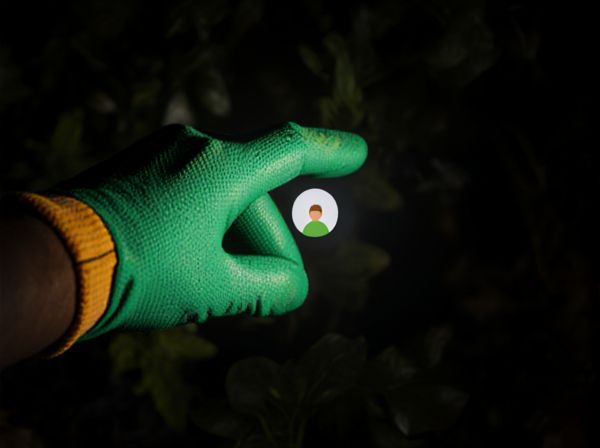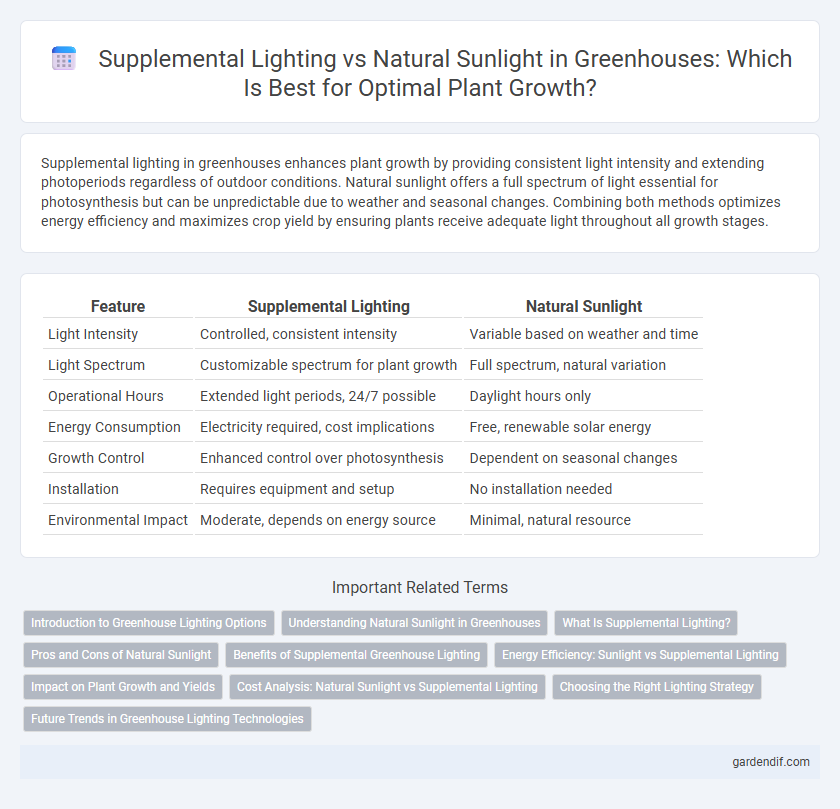
Supplemental Lighting vs Natural Sunlight Illustration
Supplemental lighting in greenhouses enhances plant growth by providing consistent light intensity and extending photoperiods regardless of outdoor conditions. Natural sunlight offers a full spectrum of light essential for photosynthesis but can be unpredictable due to weather and seasonal changes. Combining both methods optimizes energy efficiency and maximizes crop yield by ensuring plants receive adequate light throughout all growth stages.
Table of Comparison
| Feature | Supplemental Lighting | Natural Sunlight |
|---|---|---|
| Light Intensity | Controlled, consistent intensity | Variable based on weather and time |
| Light Spectrum | Customizable spectrum for plant growth | Full spectrum, natural variation |
| Operational Hours | Extended light periods, 24/7 possible | Daylight hours only |
| Energy Consumption | Electricity required, cost implications | Free, renewable solar energy |
| Growth Control | Enhanced control over photosynthesis | Dependent on seasonal changes |
| Installation | Requires equipment and setup | No installation needed |
| Environmental Impact | Moderate, depends on energy source | Minimal, natural resource |
Introduction to Greenhouse Lighting Options
Greenhouse lighting options include supplemental lighting and natural sunlight, each playing a crucial role in plant growth and development. Supplemental lighting, such as LED or HPS lamps, provides consistent light quality and intensity, extending photoperiods and optimizing photosynthesis during low sunlight periods. Natural sunlight offers full-spectrum light essential for plant health but varies with weather and season, making supplemental lighting an essential tool for controlled environment agriculture.
Understanding Natural Sunlight in Greenhouses
Natural sunlight in greenhouses provides a full spectrum of light essential for photosynthesis, growth, and flowering, making it the most efficient energy source for plants. The intensity and duration of sunlight vary with seasonal changes and geographic location, influencing plant development cycles and yield. Understanding the quality and quantity of natural sunlight enables growers to optimize greenhouse design and supplement lighting strategies for maximum crop productivity.
What Is Supplemental Lighting?
Supplemental lighting in greenhouses refers to artificial light sources used to enhance natural sunlight, ensuring plants receive adequate light for optimal growth regardless of external conditions. High-intensity discharge lamps, LED grow lights, and fluorescent lights are common types of supplemental lighting that extend photoperiods and improve photosynthesis efficiency. This technology enables consistent crop yields by compensating for insufficient natural sunlight during cloudy days or shorter daylight hours.
Pros and Cons of Natural Sunlight
Natural sunlight in greenhouses provides full-spectrum light essential for photosynthesis, promoting robust plant growth and improved flavor profiles, while being cost-free and energy-efficient. However, reliance on natural sunlight limits growth during cloudy days and winter months, potentially leading to inconsistent plant development and reduced yields. Exposure to uncontrollable environmental factors like excessive heat or shading can also stress plants, requiring additional climate management strategies.
Benefits of Supplemental Greenhouse Lighting
Supplemental greenhouse lighting enhances plant growth by providing consistent light quality and intensity regardless of external weather conditions, boosting photosynthesis and crop yields. It extends photoperiods to stimulate flowering and fruiting in greenhouse environments, ensuring faster and more uniform production cycles. This lighting also allows for precise control over light spectrum and duration, optimizing energy efficiency and maximizing plant health.
Energy Efficiency: Sunlight vs Supplemental Lighting
Natural sunlight provides a free and abundant energy source essential for photosynthesis, reducing the reliance on electrical power in greenhouses. Supplemental lighting offers precise control over light intensity and duration, optimizing plant growth but increasing energy consumption. Advanced LED systems improve the energy efficiency of supplemental lighting by targeting specific light wavelengths, minimizing power use compared to traditional lighting methods.
Impact on Plant Growth and Yields
Supplemental lighting in greenhouses enhances photosynthesis by providing consistent light intensity and spectrum, especially during low natural sunlight periods, thereby increasing plant growth rates and yields. Natural sunlight offers a full spectrum beneficial for plant development, but its variability limits growth potential in controlled environments. Combining supplemental lighting with natural sunlight optimizes energy use and maximizes crop productivity by maintaining ideal photosynthetic conditions.
Cost Analysis: Natural Sunlight vs Supplemental Lighting
Natural sunlight provides a cost-free energy source for greenhouse plants, significantly reducing operational expenses compared to supplemental lighting systems, which require substantial electricity and maintenance costs. Supplemental lighting offers consistent light intensity and duration, beneficial for maximizing crop yield during low-light conditions, but the initial investment and ongoing energy consumption can be economically challenging. Evaluating cost-effectiveness depends on local electricity rates, crop value, and climate variability, with natural sunlight favored in regions with ample sunlight and supplemental lighting preferred where light deficiencies limit plant growth.
Choosing the Right Lighting Strategy
Supplemental lighting in greenhouses enhances plant growth by providing consistent light intensity and extending photoperiods beyond natural sunlight, essential during shorter days or cloudy conditions. Natural sunlight offers full-spectrum light that supports photosynthesis but can be unpredictable due to weather and seasonal changes. Selecting the right lighting strategy depends on crop type, growth stage, and energy costs, balancing natural sunlight's benefits with supplemental lighting technology to optimize yield and energy efficiency.
Future Trends in Greenhouse Lighting Technologies
Advancements in LED supplemental lighting are transforming greenhouse cultivation by offering energy-efficient, spectrum-tailored solutions that optimize plant growth beyond natural sunlight capabilities. Emerging technologies, such as smart lighting systems integrated with AI and IoT sensors, enable dynamic light adjustments based on real-time plant needs and environmental conditions. Future trends indicate a shift toward hybrid lighting models combining natural sunlight with precision supplemental lighting to maximize crop yield, reduce energy consumption, and support sustainable agricultural practices.
Supplemental Lighting vs Natural Sunlight Infographic

 gardendif.com
gardendif.com